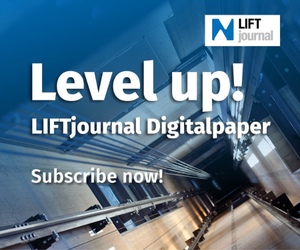Lift technology as a mirror of social change
SME lift companies need to be prepared for increasing digitalisation. Training and further education play a great role here. Lift building simultaneously has to get to grips with other important trends.
Our modern society is becoming increasingly digitalised. This process affects every aspect of our lives. Interface technologies in particular, such as lift building, located between mechanical engineering, building technology and the new urban life – in addition with the condition of already having autonomously operated systems – are very important.
However, the people and employees in this sector, which is characterised by small and medium-sized businesses, as well as the users, have to be prepared for the "new" circumstances. The group of winners and losers will be reshuffled.
This can be influenced by targeted guidance, training and further education, as demonstrated by national and international further education measures. What counts is recognising the interdisciplinary character involved and working consciously with it.
Lifts: part of the digital economy
The lift as classic representative of traction drives has to be considered as part of the digital economy and society. Consequently, it is oriented to the production-heavy subjects of Industry 4.0, but also to the new smart trends service, data handling, networking, science, education and altered living worlds.
At the same time, lift building has to get to grips with trends such as sustainable mobility, urbanisation, self-determination of life in old age, lightweight construction and energy efficiency. This also applies to internationalisation, which is becoming more complex due to the pandemic. The subjects of digital and physical security – such as resource conservation and climate neutrality – will challenge the sector to make its contribution.
From the cradle to the grave…
The desire for an individual lift (batch size "1") will expedite horizontal integration via value added networks and vertical integration via business processes. In future, this will only work by embodying the ‘from the cradle to the grave’ approach. For this, the features of quality in the product as well as in installation and maintenance are the basis - or perhaps only the objective?
Employees have to be prepared for these changed requirements. Targeted training courses with flexible offers from the VFA Academy are predestined for this. Jointly handling the insight of SMEs into a complex interdisciplinary working and industrial environment and contributing individual strengths requires trust. This is, for example, promoted by the information days of the VFA series "Smart technologies in the lift (Lift 4.0)".
Despite all the fascination for digitalisation, networking and tremendous market of options, the love of detail has to be reduced to the scale needed. This limit will have to be clarified in future by the users and providers within the policy guidelines.
Resource consumption of construction
Urban life will be redefined. The agile and mobile city that can be experienced in many different ways, where production occurs - with the compression of the living space as shared economy – already exists as a vision. The lift has to contribute its share to the use and logistics of the new buildings and structures. Smaller, lighter, more individual - these are what are desired. One has to be aware that this will result in new questions (e.g. noise emissions). This has to be taken into account in the early development phases.
We have to bear in mind that construction accounts for 50 – 60 percent of the worldwide consumption of resources and urbanisation is increasing very rapidly. Textile construction, adaptive lightweight construction, renewable and gradient materials, recyclates, etc. will undoubtedly have a great influence on the future construction style.
However, this requires an intelligent – we could call it smart – approach that reduces the demands by the conveyance technology, installations and their safety systems without endangering the safety of users.
Prof. Dr.-Ing. Wolfram Vogel
Professor Wolfram Vogel is a publicly appointed and sworn expert for lift rope and hoisting technology (expert office "Gut Achten"). He is in charge of the conception and management of the VFA series "Smart lift technologies".
More information: gutachten-vogel.de






















Write a comment